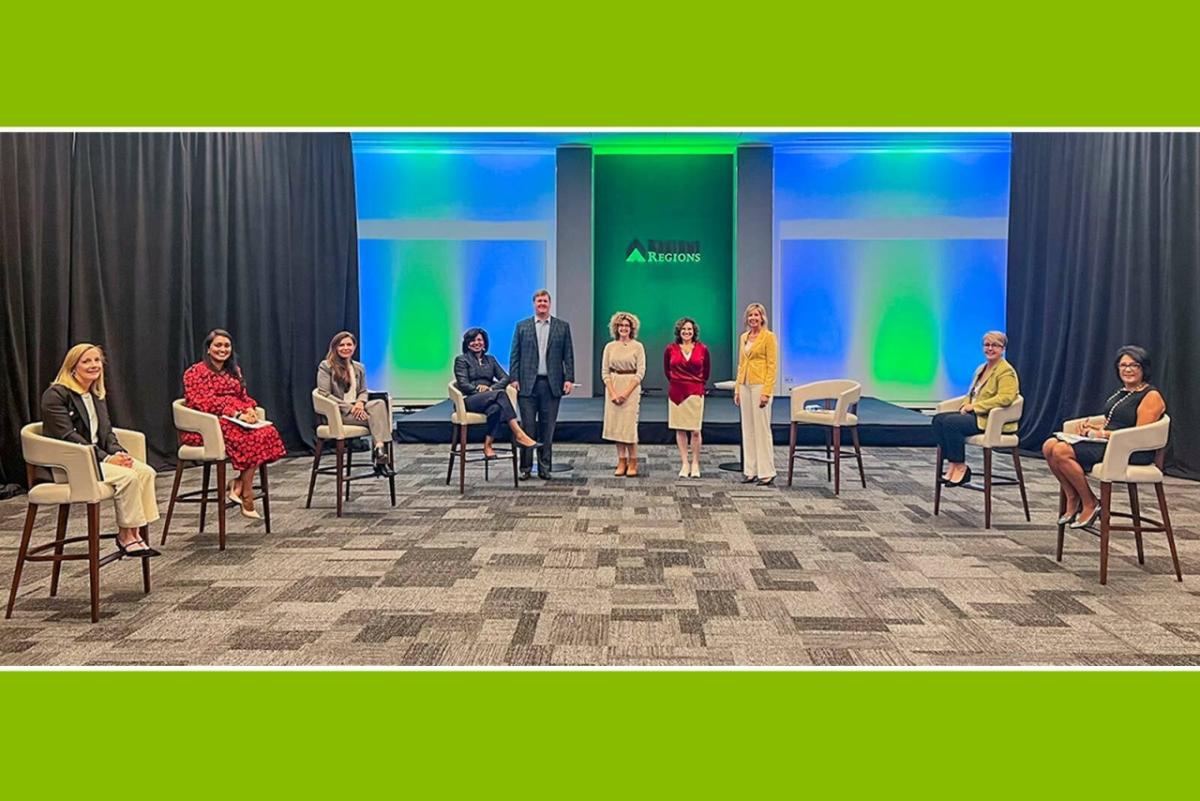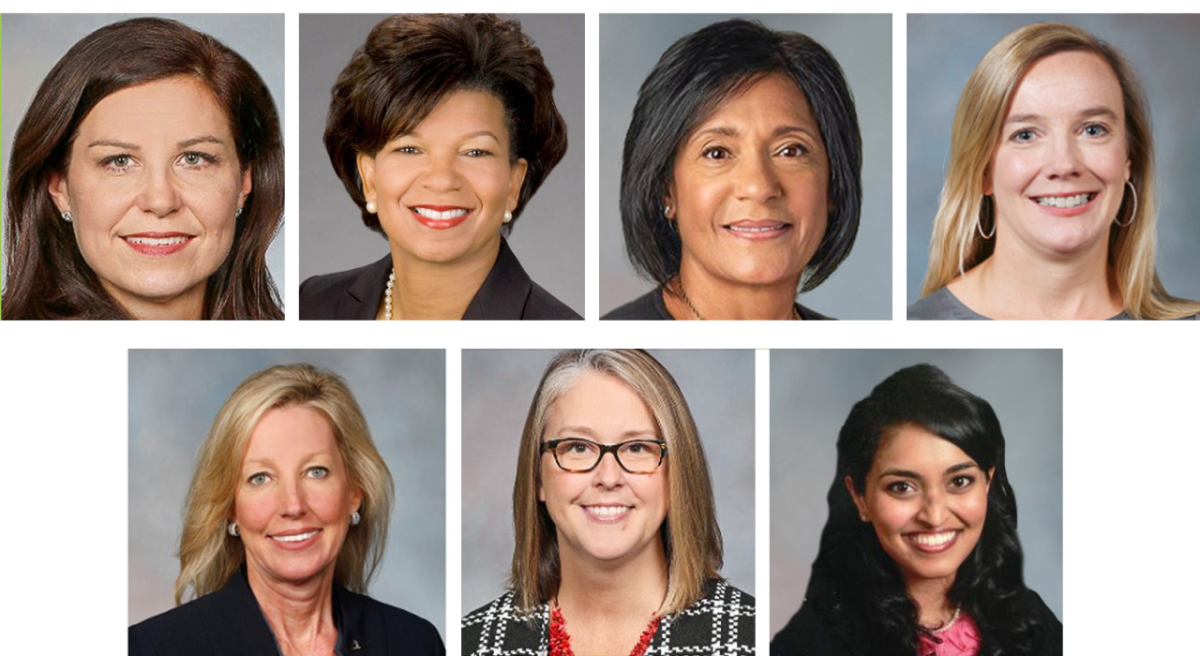Redefining What It Means to Have Work-Life Balance
Regions Women in Wealth explore the realities of work-life blend.
By Dana Obrist
Perception: A social media feed full of coordinated family photos, laughing and smiling kids, and picture-perfect healthy meals.
Reality: Living room full of overflowing laundry bins, toys scattered everywhere and microwave pizza rolls for dinner.
On March 22, the Regions Women in Wealth network, created to empower, engage and build connection with and among women (and men) across Wealth Management, hosted this empowering team at this year’s Annual Women in Wealth Forum.
Dr. Lisa Graham and Dr. Julie McDonald of McDonald Graham, an executive coaching and leadership development practice based in Birmingham, served as special guests, gathering an esteemed group of Wealth Management leaders to discuss – and dispel – the myth of work-life balance.
“The traditional model of work-life balance puts an emphasis on time and tells us we have to choose either work OR life,” shared Dr. Graham. “The reality is that this is simply unattainable.”
As an opener to the event, both Graham and McDonald shared photos of their own homes – and of themselves that captured the reality of life. Images that resonated with the seven panelists and hundreds of virtual attendees watching via WebEx.
“We are not here today professing perfection,” Graham said. “We do not have it all figured out, but we are here to share some tools to help along this journey.”
McDonald took an informal poll of the panelists, asking who among them felt they had ever achieved work-life balance for at least one week. Crickets. No one raised a hand. No one responded.
We are on the journey together
Graham and McDonald introduced a new model of work-life balance that seeks to help individuals create their own unique vision of what work-life balance (and subsequent higher life satisfaction) looks like. Dubbed the Life Elements Blend®, this new model captures the reality of the way our lives really work and is flexible enough to allow us to move through the changes – big and small – in our lives. It puts emphasis on fulfillment and the elements that ultimately contribute to life satisfaction.
“Everyone’s blend is unique,” said McDonald. “It is a moving model that changes as your day-to-day needs change or when you experience a big life event, such as a new baby.”
They introduced how to start building your unique blend through the model, sharing dozens of sample elements including: sleep, sense of achievement, authentic relationships, time alone, exercise, organization plan, physical health, emotional health, happy family, and more that easily apply across work and life planes, essentially blending the two.
Building your unique life elements blend
After panelists and virtual attendees identified their top eight elements, McDonald and Graham asked them to rate their current level of satisfaction with each element on a scale of 1 to 10.
“Be honest with yourself in terms of your life satisfaction,” said McDonald.
She then asked the panelists, “How did it feel to rate your current levels of satisfaction with each element on your blend?”
“It was really a matter of having a hard conversation with myself,” shared Denise Morrison, wealth management risk and compliance manager. “It made me start to think about communicating and being a leader. Asking myself what I need for myself and from my team to feel fulfilled and do my work. A lot of that very much carries over (between work and life).”
The next step was to evaluate your desired blend, using the same scale of 1-10 (pointing out that realistically everything cannot be a 10).
“You cannot put a 10 on everything, though that is often how we are living our lives — as though that is possible,” said Graham.
Panelists Grace Jackson, private wealth management banking products and development executive and Deena Espinosa, regions investment services area executive, found the experience of completing their blends enlightening.
“What I realized is that some of the elements, if you get them right, the rest of your blend falls into place, “said Jackson.
“It was very enlightening and put things in perspective for me,” shared Espinosa. “Incremental growth is where you want to start with that process.”
The final step came in calculating gaps between your current ratings and your desired ratings.
Panelist Adrian Hughes, regions investment management portfolio manager, shared that discovering her gaps was an eye-opening experience, and she recognized a pattern of overcommitment in her life – a pattern that led her to feel disconnected from friends and family. With a child about to go off to college, she recognized that a focus on feeling connected may help her achieve higher life satisfaction. Ultimately, she decided to let go of a few commitments to lighten her load and allow her to spend more quality time with friends and family.
McDonald reflected with the group and encouraged everyone to share their blends with those closest to them – in their personal lives and at work. She also noted that women often compare themselves to others, potentially leading to negative self-assessments.
“If you feel any negative self-talk about your own gap, know your blend is not a report card, it is a permission slip about what you need to feel fulfilled and satisfied in your life,” said McDonald. “Talk to the people in your life about closing those gaps.”
Closing the gap
“As a working mom, I was not at every class party”, McDonald said. “We have to be thoughtful and intentional about choosing our sacrifices (to focus on) what is essential to our fulfillment. You don’t have to sacrifice your time or well-being.”
When it comes to closing the gap between current ratings and desired ratings in your Life Elements Blend®, consider mindset. Do you have a fixed mindset or a growth mindset about the elements where you have the largest gap?
Citing the work of Dr. Carol Dweck, Graham suggested you can have both a fixed and growth mindset, based on different things.
“We need to give ourselves permission to try new things,” said Leslie Carter-Prall, head of Regions private wealth management
“We talk a lot about continuous improvement here at work and we can apply this concept in our personal lives. If you have children, it is a great thing to model, and it is a great thing to model for your teams.”
Carter-Prall also recommended that we ask questions and admit when we may not know the answer or aren’t great at a certain thing.
Graham affirmed, noting you cannot believe continuous improvement is possible without a growth mindset.
Personal power vs. Position power
Personal Power: Power that resides within you – personal awareness of who you are.
Position power: Power that you have in the socially defined role you are in.
The discussion continued with a focus on personal and position power and the roles they may play in our lives.
Jackson reflected on a time when she leaned into her personal power when making an important career decision.
“A few years back I was offered a terrific opportunity. I was gainfully employed and happy, I felt balanced. I am a mother of three sons, we had two children in high school at the time. I was so flattered by the offer, but I didn’t have a lot of peace about it. I had to sit down and get real and quiet with myself about why. Time with family was critical to me and had I taken that role, it would have been disruptive to relocate, and you run really hard the first few years in a new role – and the boys would be off to college soon, and I would have missed so much during those crucial high school years. I declined the offer, but it was the right decision for us at the time, as a family. Money isn’t everything and it is important to really get clear on that.”
A key to achieving higher life satisfaction is sometimes making the decisions that are right for you even if doing so is hard. It doesn’t matter what everyone else thinks.
“The culture of a company encourages or discourages the use or personal power,” said Graham. “We have to reinforce the choices that people make.”
Commit to change
What can we do to get into better alignment with our desired Life Elements Blend®?
“I journal on a daily basis, and I’m going to incorporate this into my journal,” noted Espinosa. “I’d like to look at: what did I do today to get closer to my alignment? Where could I have done something different today to get closer? And then celebrate the achievements.”
Hope Thomas, head of Regions wealth management strategy and effectiveness, concurred and expanded on her desire to spend more time in nature.
“I recognized if I do more towards reaching that alignment of getting out in nature, it will allow me to hit more on my list,” she said. “Dedicating time on my calendar to be in nature will impact health and spirituality elements. We have amazing walking and hiking trails in the area, and I want to get there again.”
Carter-Prall identified “spirituality” as one of her life elements as well.
“A couple of years ago, I was really missing the things that filled my spiritual cup,” she shared. “I took a meditation class and dove into that part of the growth mindset because I had tried some different things and hadn’t quite figured it out. I now have a reminder on my phone that pops up twice a day to remind me to meditate, but I usually think I don’t have time for that. But I am going to try to get better and dedicate that time.”
Joanna Clayton, wealth management human resources partner, is taking Graham and McDonald’s advice and sharing her Life Elements Blend® with those closest in her life, including her husband, to help keep her accountable. Clayton, who identified “feeling connected” as one of the life elements essential to her life satisfaction wants to make it a family affair.
“I’m planning to invite an accountability partner around being connected,” said Clayton. “In my case, maybe picking a safe question my family can ask to nudge me when I am disconnected.”
Thomas summed up the forum discussion well.
“Burnout is real, and everyone is experiencing that in some ways, whether in their personal life or professional life,” Thomas said. “This model and exercise is a great antidote to that.”
Bring Your Whole Self to Work
We have a passion for creating an inclusive environment that promotes and values diversity of race, color, national origin, religion, age, sexual orientation, gender identity, disability, veteran status, genetic information, sex, pregnancy, and many other primary and secondary dimensions that make each of us unique as individuals and provide valuable perspective that makes us a better company and employer. More importantly, we recognize that creating a workplace where everyone, regardless of background, can do their best work is the right thing to do.
OFCCP Disclosure: Equal Opportunity Employer/Disabled/Veterans




